#microscopic life
Text
Bdelloid rotifer eating
This little animal uses its ciliae rings to aspire water, then it grinds it with its mastax organ. It mostly eats organic detritus and other microorganisms.
#rotifer#bdelloid#rotifera#bdelloidae#microorganisms#microbiome#microscopic life#microbiology#microscope#little animals#biology#protists
249 notes
·
View notes
Text

DROPS OF WATER: THEIR MARVELOUS AND BEAUTIFUL INHABITANTS DISPLAYED BY THE MICROSCOPE by Agnes Catlow (London: Reeve and Benham, 1851). Illustrated.
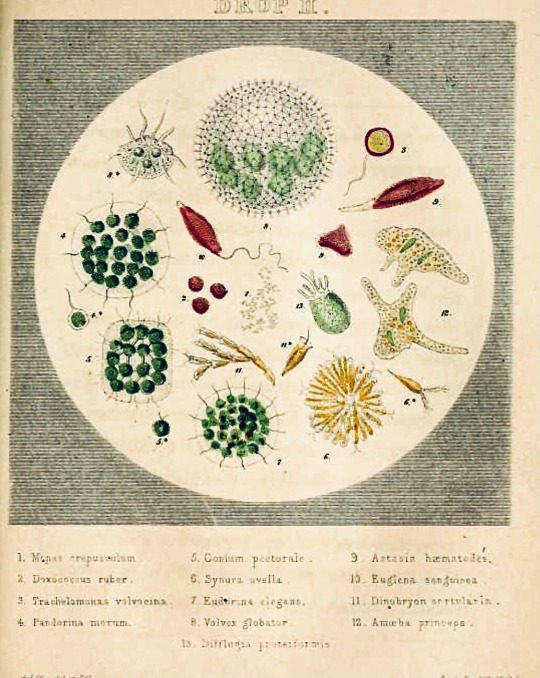


source
#beautiful books#book blog#books books books#book cover#books#vintage books#illustrated book#nonfiction#biological diversity#microscopic life#book binding#book design
66 notes
·
View notes
Text

73 notes
·
View notes
Photo

Euglena (Euglena spp.)
Family: Euglenoid Family (Euglenaceae)
IUCN Conservation Status: Unassessed
The members of the genus Euglena are microscopic, single-celled eukaryotes that can be found in large numbers in both marine and freshwater habitats worldwide. Exactly what they are, taxonomically speaking, has been the subject of extensive debate: like plants, their bodies contain chloroplasts filled with large amounts of the green pigment chlorophyll which allows them to absorb sunlight and carry out photosynthesis to sustain themselves, but like animals, they are capable of “eating” (when faced with low light levels that impair their ability to carry out photosynthesis they can secrete enzymes that break down dead organic matter in the water around them, allowing them to absorb nutrients from this matter through their cell membranes), moving (with a pair of tiny tail-like structures, known as flagella, allowing them to swim towards food and away from predators such as larger single-celled organisms and tiny animals such as rotifers and fish larvae) and rudimentary “seeing” (with a single redish-orange “eye spot” filtering sunlight onto a light-sensitive structure at the base of the flagella and thereby forming something comparable to a very basic eye, allowing Euglena species to distinguish between light and dark and move towards sunlight.) As such, most authorities now classify Euglena and its relatives as protists, a sort of “miscellaneous” category that includes all eukaryotic organisms that are not animals, plants or fungi. When faced with dry conditions or a lack of sunlight and food, Euglena species can encase themselves in a protective membrane and enter a dormant state until they encounter preferable conditions, and when conditions are ideal they reproduce through binary fission, a form of asexual reproduction in which a single-celled organism essentially makes a copy of its genetic material, separates these two copies at opposite ends of its body and then splits into two distinct but genetically identical individuals. When sunlight is intense and water is abundant, these organisms may reproduce so frequently that the water they live in begins to appear green (or, in the case of the species Euglena sanguinea which uniquely possesses a protective casing of the reddish substance astaxanthin around its chloroplasts to protect them from damage from intense UV radiation, red.)
(Note - on the individual pictured above, the orange mark near the top of the image is the eye spot. The flagella are tiny and transparent so are very hard to see through most microscopes, but they’re there - I promise!)
--------------------------------------------------------------------------
Not an animal per say, but a poster I was given for Christmas had these little goopy guys on it and I wanted to learn more about them. I think they’re cool, and while they’re not easily visible protists are still wildlife!
Image Source: https://www.inaturalist.org/taxa/203631-Euglena
#Euglena#protist#protists#euglenoids#protistology#biology#wildlife#aquatic wildlife#marine wildlife#marine biology#NOT zoology this time#microscopic life#microscopic wildlife#single-celled organisms#I swear they're cool they're NOT boring they're cool guys come on
69 notes
·
View notes
Text
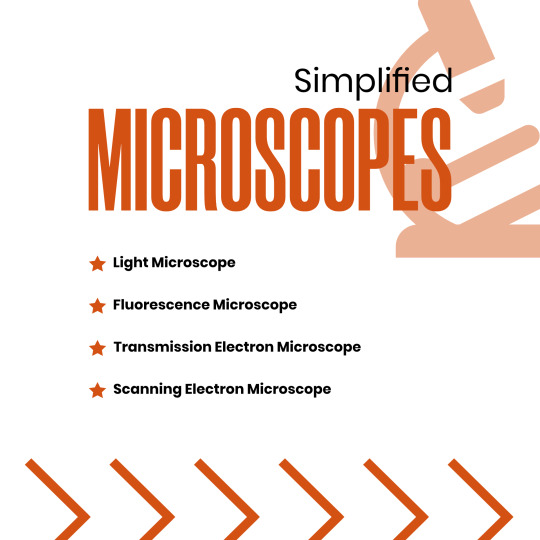

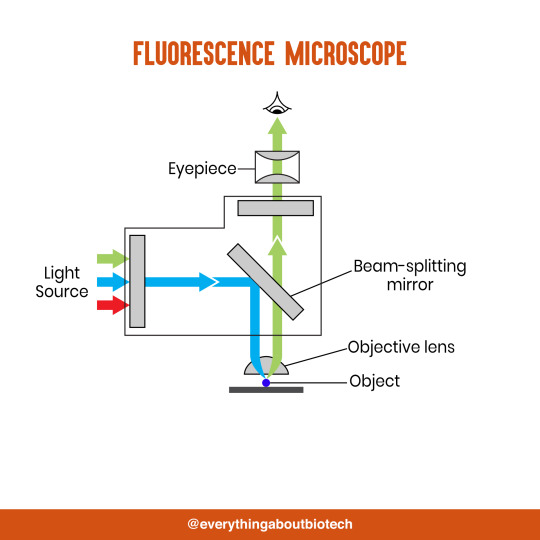



Microscopes Simplified
Light Microscope
Fluorescence Microscope
Transmission Electron Microscope
Scanning Electron Microscope
#microscope#light microscope#Fluorescence Microscope#Transmission Electron Microscope#Scanning Electron Microscope#microscopic#science#microscopy#microscopic life#biotechnology#biotech#biology#biochemistry#studyblr#molecularbiology#notes#class notes#students#science illustration#illustration#illustragram#scientific illustration#graphic design#graphicwork#study notes#study#study motivation#study tips#studygram
81 notes
·
View notes
Photo





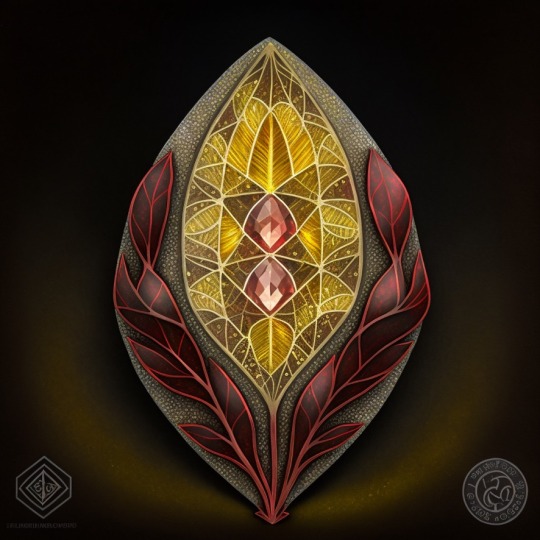




Diatoms Are Forever
O.K. no, they are not forever. But the artwork? It could last forever. During these times (maybe one day we shall enter 1900...) we are seeing a number of artists competing for the best diatom arrangement & some of the more talented amongst have vowed to new share the secret of their immaculate methods. Many of us are familiar with the Cloistered Diatomist (the Monastic Diatomist is also a rising talent). While he would not allow his method to be shared nor publicised (very reclusive), we did find several Bohemians willing to share.
In the process of trial & arso...error, I found some amusing ways to break the diatom’s place on the Great Chain & found a way to have a large window created with diatoms (stained glass is very 1899 [the first one]) in my Embassy Suites. Millions of diatoms & like the people who must silence the surrounding grounds of the palace over & over, the Monastic Diatomist is giddy (for him) to continually make a living piece of art that people HAVE to look at to get in my home. Especially since it requires a very secretive method & the diatom art movement loves nothing more than secrets...
[For interesting information in this, the year of Victoria 1899 the 123rd, there is an artist named Klau Kemp doing diatom art & is self-taught because the Victorians of 1899 would have taken their methods to the grave, so secretive an art form it was. For more: https://www.smithsonianmag.com/arts-culture/secretive-victorian-artists-made-these-intricate-patterns-out-of-algae-180952720/ which has led me to really dig this little art form. It’s my second favourite weird Victorian thing I’ve found. The first will always be spirit signatures... I LOVE THOSE so much.]
#ai artwork#ai art#midjourney#fallen london#failbetter games#diatom#diatoms#microscopic art#microscopic life#diatomist#stained glass#victorians#1800s#Klaus Kemp
23 notes
·
View notes
Text

My tardigrade design is now finished!
You can get this little guy on a variety of products over on my RedBubble <3
#redbubble#tardigrade#moss piglet#water bear#biology#microbiology#science#microscopic life#digital art
35 notes
·
View notes
Photo

Under the Microscope
Look closer and discover a whole new world
#Photoshop Manipulation#photo manipulation#image manipulation#graphic design#graphic arts#microscopic life
7 notes
·
View notes
Video
I made a new poster, it's a tardigrade studying microbiology!
If you're like me and love science and animals, or have a super cool kid who is into science, go check out my other posters in my Displate shop.
I draw various animals that study different fields of science, they are professionals!
Big thank you to James Weiss for reference photos for this poster and for just being out there doing what he does! 💖🔬
•
Thank you for watching and reading!
Music: Mad Steampunk Scientist's Lab by NaturesEye
#microbiology#tardigrade#tardigrades#moss piglet#water bear#microscopy#microscopic life#microscopic#microscopic animals#microcosmos#art#drawing#Digital Illustration#illustration#cute#science#poster design#art poster#original art#Original Artwork#science love#science drawing#stem#stemblr#stemforkids#SKETCHY STYLE#science sketch#stem education#wall art#independent artist
6 notes
·
View notes
Text
Little lovely springtails 😍
#springtail#little animals#microscopic life#microbiome#microscope#arthropods#collembola#collembole#hexapod#cute#cute animals#microbiology
325 notes
·
View notes
Text

11 notes
·
View notes
Text

Eater, little eater
Takes from me without reserve
Together we feast on that we don't deserve
Eat fast, fast eater
Take my child, take my body
Sever the root of hope and boil it down
Give to me loneliness, steamed and ripe
Now fast, fast eater
Your hunger. Divine.

Eater, big eater
So small but such an appetite
Such suffering, our bellies ache as we fight
Eat fast, cruel eater
Punish us who cannot provide
So much smoke and tears I will give to you
My penance does not fill your stomach one drop
Cruel fast, fast eater
Your hunger. Sheer pain.
Eater, whole eater
Swallow swallow. Swallow rhythm, swallow rhyme
Tear out the heart of me and put it to page
Burn me inside for a well cooked feast
Squeeze out the transudate to rinse your throat.
My own is a charcoal tube, never to sing again.
The pace matters no more, the song is dead.
This cantor sacrifices his music upon your alter
And so an ugly prose rears its head
Little eater rears their head
Eater, little eater
Take from me without reserve
Today you may feast on that you don't deserve

Crappy slide photos from me, ask if you are interested in what they are.
#bad poetry#poetry#biology#photography#i hate myself#poem#bad poem#writing#bad writing#not a writer#not a fandom post#got a lot going on#just worked a 13 hour shift#im tired#life is hard#microscopic life#experimental poetry
3 notes
·
View notes
Text
Microbiology 🧫 ❤️
2 notes
·
View notes
Text
Anton van Leeuwenhoek and The Unseen World

By holding his brass microscope toward a source of light, van Leeuwenhoek was able to observe living organisms too small to be seen with the unaided eye.

The specimen was placed on the tip of the adjustable point and viewed from the other side through the tiny, nearly spherical lens. The highest magnification possible with his microscopes was about
3003 (times).
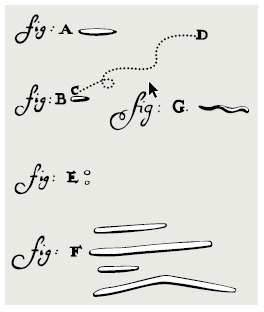
Some of van Leeuwenhoek’s drawings of bacteria were made in 1683. The letters represent various shapes of bacteria. C–D represents a path of motion he observed
~Courtesy of Pearson
#microoganisms#bacteria#microscopic#microscope#microscopy#microscopic life#biotech#biotechnology#science#biology#biochemistry#studyblr#molecularbiology#notes#class notes#students#unseen#facts#factoftheday#ultrafacts#random fact#history#life sciences#microbiologist#microbiology
30 notes
·
View notes

